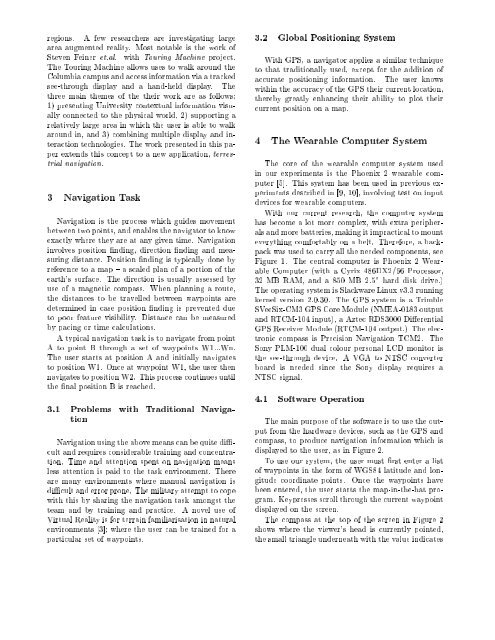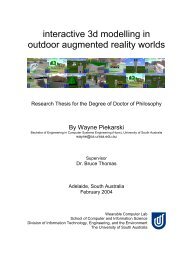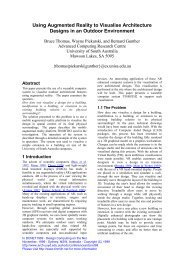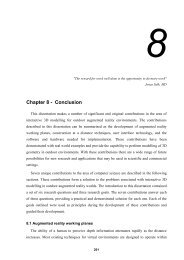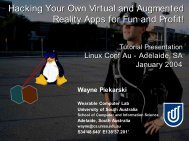A Wearable Computer System with Augmented Reality to Support ...
A Wearable Computer System with Augmented Reality to Support ...
A Wearable Computer System with Augmented Reality to Support ...
You also want an ePaper? Increase the reach of your titles
YUMPU automatically turns print PDFs into web optimized ePapers that Google loves.
egions. A few researchers are investigating largearea augmented reality. Most notable is the work ofSteven Feiner et.al. <strong>with</strong> Touring Machine project.The Touring Machine allows uses <strong>to</strong> walk around theColumbia campus and access information via a trackedsee-through display and a hand-held display. Thethree main themes of the their work are as follows:1) presenting University contextual information visuallyconnected <strong>to</strong> the physical world, 2) supporting arelatively large area in which the user is able <strong>to</strong> walkaround in, and 3) combining multiple display andinteractiontechnologies. The work presented in this paperextends this concept <strong>to</strong> a new application, terrestrialnavigation.3 Navigation TaskNavigation is the process which guides movementbetween twopoints, and enables the naviga<strong>to</strong>r <strong>to</strong> knowexactly where they are at any given time. Navigationinvolves position nding, direction nding and measuringdistance. Position nding is typically done byreference <strong>to</strong> a map { a scaled plan of a portion of theearth's surface. The direction is usually assessed byuse of a magnetic compass. When planning a route,the distances <strong>to</strong> be travelled between waypoints aredetermined in case position nding is prevented due<strong>to</strong> poor feature visibility. Distance can be measuredby pacing or time calculations.Atypical navigation task is <strong>to</strong> navigate from pointA <strong>to</strong> point B through a set of waypoints W1...Wn.The user starts at position A and initially navigates<strong>to</strong> position W1. Once at waypoint W1, the user thennavigates <strong>to</strong> position W2. This process continues untilthe nal position B is reached.3.1 Problems <strong>with</strong> Traditional NavigationNavigation using the above means can be quite dicultand requires considerable training and concentration.Time and attention spent onnavigation meansless attention is paid <strong>to</strong> the task environment. Thereare many environments where manual navigation isdicult and error prone. The military attempt <strong>to</strong> cope<strong>with</strong> this by sharing the navigation task amongst theteam and by training and practice. A novel use ofVirtual <strong>Reality</strong> is for terrain familiarisation in naturalenvironments [3] where the user can be trained for aparticular set of waypoints.3.2 Global Positioning <strong>System</strong>With GPS, a naviga<strong>to</strong>r applies a similar technique<strong>to</strong> that traditionally used, except for the addition ofaccurate positioning information. The user knows<strong>with</strong>in the accuracy of the GPS their current location,thereby greatly enhancing their ability <strong>to</strong> plot theircurrent position on a map.4 The <strong>Wearable</strong> <strong>Computer</strong> <strong>System</strong>The core of the wearable computer system usedin our experiments is the Phoenix 2 wearable computer[5]. This system has been used in previous experimentsdescribed in [9, 10], involving test on inputdevices for wearable computers.With our current research, the computer systemhas become a lot more complex, <strong>with</strong> extra peripheralsand more batteries, making it impractical <strong>to</strong> mounteverything comfortably on a belt. Therefore, a backpackwas used <strong>to</strong> carry all the needed components, seeFigure 1. The central computer is Phoenix 2 <strong>Wearable</strong><strong>Computer</strong> (<strong>with</strong> a Cyrix 486DX2/66 Processor,32 MB RAM, and a 850 MB 2.5" hard disk drive.)The operating system is Slackware Linux v3.3 runningkernel version 2.0.30. The GPS system is a TrimbleSVeeSix-CM3 GPS Core Module (NMEA-0183 outputand RTCM-104 input), a Aztec RDS3000 DierentialGPS Receiver Module (RTCM-104 output.) The electroniccompass is Precision Navigation TCM2. TheSony PLM-100 dual colour personal LCD moni<strong>to</strong>r isthe see-through device. A VGA <strong>to</strong> NTSC converterboard is needed since the Sony display requires aNTSC signal.4.1 Software OperationThe main purpose of the software is <strong>to</strong> use the outputfrom the hardware devices, such as the GPS andcompass, <strong>to</strong> produce navigation information which isdisplayed <strong>to</strong> the user, as in Figure 2.To use our system, the user must rst enter a lis<strong>to</strong>f waypoints in the form of WGS84 latitude and longitudecoordinate points. Once the waypoints havebeen entered, the user starts the map-in-the-hat program.Keypresses scroll through the current waypointdisplayed on the screen.The compass at the <strong>to</strong>p of the screen in Figure 2shows where the viewer's head is currently pointed,the small triangle underneath <strong>with</strong> the value indicates


